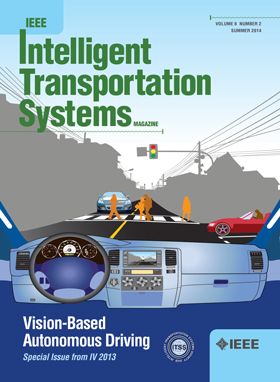利用点网划分机载雷达点云中的无人机碰撞危险
IF 7.9
1区 工程技术
Q1 ENGINEERING, CIVIL
IEEE Transactions on Intelligent Transportation Systems
Pub Date : 2024-08-30
DOI:10.1109/TITS.2024.3442668
引用次数: 0
摘要
将无人机整合到共享空域进行超视距(BVLOS)操作是一项重大挑战,但对运输、建筑、能源和国防等部门来说却具有变革潜力。整合的先决条件是使无人机具备更强的态势感知能力,以确保避免碰撞和安全运行。目前的方法主要针对单个物体检测或分类,或提供有限感知理解的简单传感输出,缺乏将传感器数据转化为安全关键见解所需的快速端到端处理。相比之下,我们的研究利用雷达技术对空中点云进行新颖的端到端语义分割,以同时识别多种碰撞危险。通过调整和优化 PointNet 架构并整合航空领域的见解,我们的框架区分了五个不同的类别:移动目标(如无人机(大疆 M300 和大疆 Mini)和飞机(Ikarus C42))以及静态回波(地面和基础设施),从而增强了无人机的态势感知能力。据我们所知,这是第一种在空中同时识别多种碰撞威胁的方法,准确率高达 94%。这项工作凸显了雷达技术在提高无人机态势感知能力方面的潜力,有助于安全、高效地进行无损低空(BVLOS)作业。本文章由计算机程序翻译,如有差异,请以英文原文为准。
Segmentation of Drone Collision Hazards in Airborne RADAR Point Clouds Using PointNet
The integration of drones into shared airspace for beyond visual line of sight (BVLOS) operations presents significant challenges but holds transformative potential for sectors like transportation, construction, energy and defence. A prerequisite for this integration is equipping drones with enhanced situational awareness to ensure collision avoidance and safe operations. Current approaches mainly target single object detection or classification, or simpler sensing outputs that offer limited perceptual understanding and lack the rapid end-to-end processing needed to convert sensor data into safety-critical insights. In contrast, our study leverages radar technology for novel end-to-end semantic segmentation of aerial point clouds to simultaneously identify multiple collision hazards. By adapting and optimizing the PointNet architecture and integrating aerial domain insights, our framework distinguishes five distinct classes: mobile targets like drones (DJI M300 and DJI Mini) and airplanes (Ikarus C42), and static returns (ground and infrastructure) which results in enhanced situational awareness for drones. To our knowledge, this is the first approach addressing simultaneous identification of multiple collision threats in an aerial setting, achieving a robust 94% accuracy. This work highlights the potential of radar technology to advance situational awareness in drones, facilitating safe and efficient BVLOS operations.
求助全文
通过发布文献求助,成功后即可免费获取论文全文。
去求助
来源期刊

IEEE Transactions on Intelligent Transportation Systems
工程技术-工程:电子与电气
CiteScore
14.80
自引率
12.90%
发文量
1872
审稿时长
7.5 months
期刊介绍:
The theoretical, experimental and operational aspects of electrical and electronics engineering and information technologies as applied to Intelligent Transportation Systems (ITS). Intelligent Transportation Systems are defined as those systems utilizing synergistic technologies and systems engineering concepts to develop and improve transportation systems of all kinds. The scope of this interdisciplinary activity includes the promotion, consolidation and coordination of ITS technical activities among IEEE entities, and providing a focus for cooperative activities, both internally and externally.
 求助内容:
求助内容: 应助结果提醒方式:
应助结果提醒方式:


